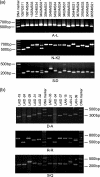Evidence for a link between parasite genotype and outcome of infection with Entamoeba histolytica
- PMID: 17122021
- PMCID: PMC1829016
- DOI: 10.1128/JCM.01335-06
Evidence for a link between parasite genotype and outcome of infection with Entamoeba histolytica
Abstract
The factors determining whether a person infected with Entamoeba histolytica develops disease remain obscure. To investigate whether the parasite genome contributes to the outcome, we have investigated the distribution of parasite genotypes among E. histolytica-infected individuals in Bangladesh. Samples were obtained from individuals who either were asymptomatic, had diarrhea/dysentery, or had developed a liver abscess. Genotypes were determined by using six tRNA-linked polymorphic markers, and their distributions among the three sample groups were evaluated. A significant population differentiation in the genotype distribution was found for four of the six individual markers as well as for the combined genotypes, suggesting that the parasite genome does contribute in some way to the outcome of infection with E. histolytica. The markers themselves do not indicate the nature of the underlying genetic differences, but they may be linked to loci that do have an impact on the outcome of infection.
Figures

References
-
- Ayeh-Kumi, P. F., I. M. Ali, L. A. Lockhart, C. A. Gilchrist, W. A. Petri, Jr., and R. Haque. 2001. Entamoeba histolytica: genetic diversity of clinical isolates from Bangladesh as demonstrated by polymorphisms in the serine-rich gene. Exp. Parasitol. 99:80-88. - PubMed
-
- Clark, C. G. 2006. Methods for the investigation of diversity in Entamoeba histolytica. Arch. Med. Res. 37:258-262. - PubMed
-
- Clark, C. G., I. K. M. Ali, M. Zaki, B. J. Loftus, and N. Hall. 2006. Unique organisation of tRNA genes in Entamoeba histolytica. Mol. Biochem. Parasitol. 146:24-29. - PubMed
Publication types
MeSH terms
Grants and funding
LinkOut - more resources
Full Text Sources
Other Literature Sources

